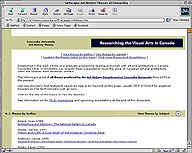




 |
 |
|
 |
 |
 |
|
ART HISTORY: Loren Lerner |
|
|
|
|
ASSIGNMENT:
|
||
|
PUBLICATIONS: Canadian
Artists of Eastern European Origin. Canadian Heritage, Multiculturalism
Canada research grant, 1999. |
||
 "Researching
the Visual Arts" . Teaching Development grant, Concordia University
(with co-investigators Catherine MacKenzie, Jean Bélisle, Brian Foss).
1998. "Researching
the Visual Arts" . Teaching Development grant, Concordia University
(with co-investigators Catherine MacKenzie, Jean Bélisle, Brian Foss).
1998. |
||
| Canadian
Film and Video: A Bibliography and Guide to the Literature/Film et vidéo
canadiens: bibliographie et guide de la documentation.Toronto: University of Toronto Press, 1997.
|
||
|
|
||
|
Taylor,
James and Loren Lerner. "Making sense of sensemaking: How managers
construct their organization through their talk." Studies in Culture,
Organizations and Societies 2 (1996); 257-286. |
||
|
"Communication
Studies". Proceedings of the Third National Conference on Canadian
Bibliography held in Charlottetown on 31 May and 1 June 1992. The Bibliographical
Society of Canada and the Association of Canadian Studies, 1994.
|
||
| Art
and Architecture in Canada: A Bibliography and Guide to the Literature/Art
et architecture au Canada: une bibliographie et guide de la documentation,
Co-editor with Mary Williamson. Toronto: University of Toronto Press, 1991. |
||
|
|
||
|
PRESENTATIONS:
"Monet's
Private Gardens at Giverny: The Metamorphosis of Effect into "The
Shadow of the Holocaust in Contemporary Canadian Art." The Centre
for Community and Ethnic Studies, Montreal (February 3, 1999). "Remembrances
and Reinterpretations: Jewish Identity in Contemporary Canadian Art."
Canadian Council for Reform Judaism Biennial, Toronto "Montreal
of the 1970s in the Prints of Hungarian-Canadian Artist Eva Landori."
Universities Art Association of Canada, University of Western "Rita
Briansky's Kaddish Series: A Memorial to the Victims of the Holocaust."
Held in conjunction with the exhibition at the Temple Emanu-El Beth Sholom
co-sponsored with the Montreal Memorial Holocaust Centre (June 7, 1998). "Shifting
Diaspora: An Exploration of Generational, Intercultural, and Territorial
Identities of Lev and Dina Podolsky, Father and Daughter Refusenik Artists."
Universities Art Association of Canada, Emily Carr College of Art, Vancouver
(November 7, 1997). |

|
||
|
TEACHING:
|
||
|
EXHIBITIONS
IN PROGRESS:
|
||
|
Exhibition
Title (tentative): Testimonies and Memories "Testimonies
and Memories" is an exhibition of art works in different media |